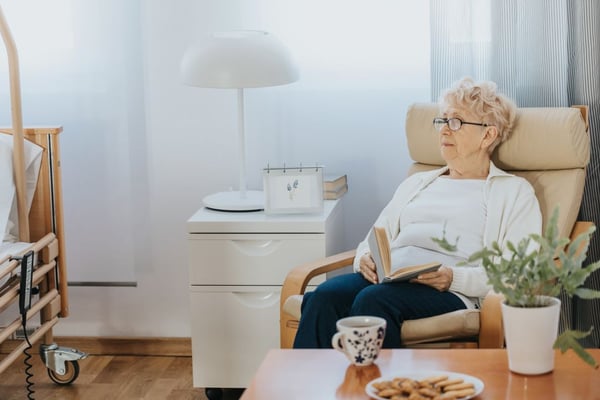
The COVID-19 pandemic continues to spread across the United States. In Alabama, as of April 17th, there had been over 4000 confirmed cases of novel coronavirus and 172 deaths. Of those fatalities, 72% were aged 65 or older. The Center for Disease Control reports that older adults and those with underlying health conditions are most at risk of developing more severe illnesses as a result of coronavirus infection. Inpatient rehabilitation facilities and other long-term care facilities are at particular risk, and strict safety regulations are therefore in place in facilities across the United States.
How Is COVID-19 Spreading?
Current evidence suggests that COVID-19 primarily spreads through respiratory droplets, reports the World Health Organization. This means that most people are infected by being in close contact with someone infected with COVID-19 who is coughing or sneezing. Transmission can also occur if someone touches an object or surface that has been recently coughed or sneezed on by an infected person.
It is still not completely clear if the disease is also airborne. Airborne viruses float in the air for minutes or hours after an infected person has been there. The WHO suggests that airborne transmission does not seem to be common—for instance, out of 75,465 cases of COVID-19 they studied in China, none of them appeared to result from airborne transmission.
Airborne transmission is a particular issue for healthcare facilities. Many medical procedures and treatments, such as intubation, manual ventilation, or turning the patient, encourage the release of “aerosols,” tiny floating particles of saliva that may well be contagious.
What Does This Mean for Inpatient Rehabilitation Facilities?
Long-term care facilities and inpatient rehab centers are facing a serious challenge. Patients in these facilities are the most at risk of developing severe complications if they catch COVID-19. The Governor of Alabama has therefore issued a statewide public health order, which prohibits all long-term care facilities and nursing homes from allowing the “visitation of all visitors and non-essential health care personnel, except for certain compassionate care situations such as maternity and end-of-life.”
This means that people are currently not allowed to visit their family members and loved ones in long-term care facilities and nursing homes. There’s no doubt that this is a very tough situation, for both the families and the patients. However, there are many tragic examples from around the world of what can happen if this policy is not introduced and strictly enforced.
Case Study: What We Can Learn from Sweden
In contrast to neighboring countries in Europe, Sweden has focused on isolating and treating those showing symptoms of COVID-19, rather than imposing quarantine on a massive scale. Unfortunately, today Sweden is facing what a local official has called a “storm” of COVID-19 cases in long-term care facilities.
The Swedish government stresses that they have insisted on social distancing and increased hygiene measures. And, indeed, while Sweden’s overall fatality rates are higher than neighboring countries, they remain much lower than those in other European countries like Spain or Italy.
However, it seems that allowing visitors into long-term care facilities may have been the reason for the higher levels of fatalities. Lena Einhorn, a virologist who has been outspoken in her criticism of her government’s more lenient policies, suggests that the issue is the spread of the disease by those not yet showing symptoms. Sweden’s policies hinge on healthcare staff and visitors self-isolating if they become sick, but this does not take into account the possibility that people with no symptoms may also be contagious.
There is widespread agreement that long-term care facilities and nursing homes in Sweden did not take enough measures to keep the patients in their care safe from infection. “The protection for people in elderly care should have been better,” commented Swedish Prime Minister Stefan Lofven.
How To Protect Patients in Inpatient Rehab Facilities
While much is still unclear about the COVID-19 pandemic, governments and health authorities around the world agree that the elderly and those with underlying conditions are most at risk. Long-term care facilities must, therefore, continue to restrict visitors to only those essential to patient care.
At Rehab Select, we know that not being able to see your family members and loved ones during this time of additional anxiety is extremely difficult. However, we must place the health and safety of the patients in our care above all else. To reduce the risk of COVID-19 infection in our facilities, we are following the rigorous guidelines proposed by the Center for Disease Control, which include:
- Limiting the points of entry into facilities to make sure that we carefully manage who is coming in and out;
- Conducting comprehensive screening of all healthcare personnel for symptoms before every shift;
- Emphasizing hand hygiene and implementing the strictest possible hygiene measures throughout all facilities, and ensuring all staff and residents have access to hand sanitizer;
- Providing staff with face masks, gloves, and other protective equipment;
- Checking all our residents for a fever or other COVID-19 symptoms on a daily basis;
- Insisting that any workers who feel unwell must take sick leave, and communicating our sick leave policies to all employees;
- Ensuring that all staff are up to date on the latest policies, safety measures, and restrictions that apply to our facilities.
We know that many of you are very concerned about the health and safety of the family members and loved ones in our long-term care facilities. We would like to take this opportunity to assure you that, while you may not be able to visit your loved ones at this time, we are putting all our efforts into keeping them safe, reassured, and well.
Learn more about how we are minimizing COVID-19 risks and see examples of how we are adapting to this challenge.





